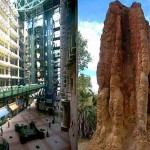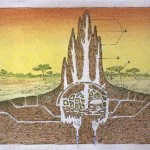Mar06
Innovation: Harnessing 3.8 Billion Years of R&D
Point: If you’re stuck on how to solve a problem, see if nature has already solved that problem.
Story: Nature has already solved many challenges; the best solutions have survived and improved through evolution.
Consider this example: termite mounds such as those of the Macrotermes michaelseni exist in African environments where the external temperature varies from 35°F at night to 104°F during the day. The living areas inside the termite mounds, however, maintain a constant internal temperature within one degree of 87 °F, day and night. Millions of years of evolution perfected the termites’ construction habits so that their mounds’ passive solar design and networks of air conduits create a self-cooling ventilation system.
How can humans put this termite-inspired solution to use? Architect Mick Pearce collaborated with engineers at Arup Associates to design a mid-rise building in Harare, Zimbabwe, called Eastgate, that has no air-conditioning, yet stays cool. The Eastgate Center is the largest office and shopping complex in Zimbabwe, but it uses only only 10% of the energy of a conventional building its size. Not only is this good for the environment, but it lowers costs for building occupants. Eastgate occupants pay 20% lower rents than do occupants in nearby buildings pay.
How did Pearce design this building? He looked a 3D digital scans of termite mounds, manipulating them in computer models to understand how the tunnel system works to exchange gases and regulate temperature and humidity. It turns out that the termite mounds operate on a system of convection currents that draw air at the lower part of the mound down to the bottom and then exhaust heated air to the top. The termites open and close ducts by digging new vents and plugging up old ones. At Eastgate, Pearce installed electronically-controlled fans on the first floor to suck in outside air and then push it up along a central spine, venting it through chimneys at the top.
computer models to understand how the tunnel system works to exchange gases and regulate temperature and humidity. It turns out that the termite mounds operate on a system of convection currents that draw air at the lower part of the mound down to the bottom and then exhaust heated air to the top. The termites open and close ducts by digging new vents and plugging up old ones. At Eastgate, Pearce installed electronically-controlled fans on the first floor to suck in outside air and then push it up along a central spine, venting it through chimneys at the top.
Action
- If you have a problem to solve, think about the plants and animals that may have had the similar problem. Look to sites like AskNature.org or the Biomimicry 3.8 Institute
- Study nature for inspirations and ideas that you can adapt
- If you don’t have time to do this yourself, consider holding an innovation contest with InnoCentive, NineSigma, or Yet2.com to solicit ideas from biologists, oceanographers, etc. who could apply knowledge from the biological world to tackle your problem.
Sources:
Janine Beyrus, Biomimicry: Innovation Inspired by Nature, chapter 1
Abigail Doan, Green Building in Zimbabwe Modeled After Termite Mounds | Inhabitat – Sustainable Design Innovation, Eco Architecture, Green Building
Comments Off on Innovation: Harnessing 3.8 Billion Years of R&DCase study, How-to, Innovation









